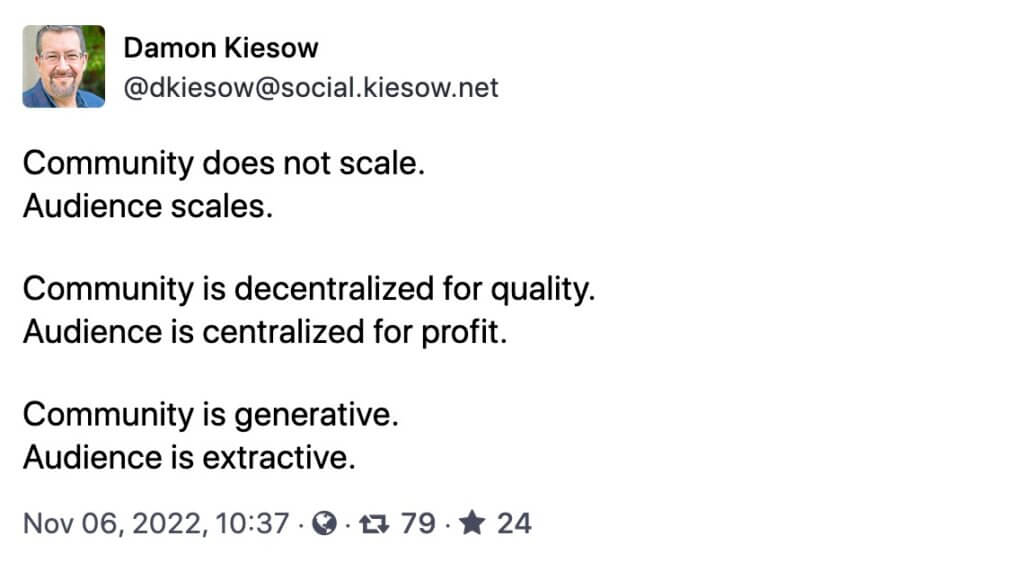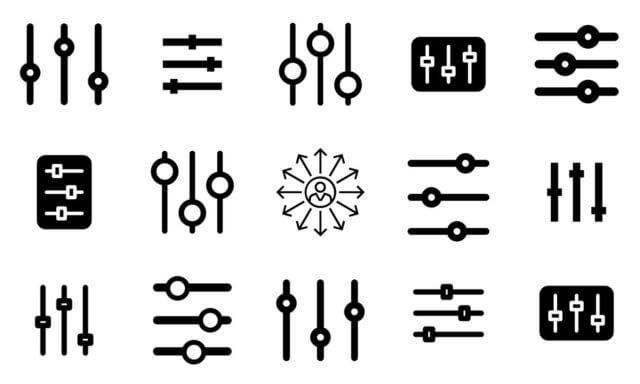Community versus audience in journalism and meetings
Many meetings still focus on creating audiences rather than community. Yes, there’s a big difference. And not just at meetings. Here’s how Damon Kiesow, Knight Chair for Digital Editing and Producing at the Missouri School of Journalism, compares the concepts of community versus audience from a journalistic perspective.
Kiesow says:
Community does not scale.
Audience scales.
Community is decentralized for quality.
Audience is centralized for profit.
Community is generative.
Audience is extractive.
—Damon Kiesow, @[email protected], Mastodon toot on Nov 06, 2022, 10:37
Kiesow concisely sums up why the news business and the meeting industry concentrate on audience rather than community. When media and meeting owners focus on short-term interests—big circulations and audiences, leading to higher status and consequential larger profits at the expense of “consumers”—it’s understandable that building community plays second fiddle to chasing media visibility and large audiences.
Jeff Jarvis’s perspective
Another media professional—journalist, professor, columnist, and author Jeff Jarvis—writes about similar themes. (These two quotes are from my posts on the parallels between the evolution of journalism and events (2015) and on the parallel missions of journalism and participant-driven and participation-rich events (2018).]
“What the internet changes is our relationship with the public we serve…What is the proper relationship for journalists to the public? We tend to think it’s manufacturing a product called content you should honor and buy…That’s a legacy of mass media; treating everybody the same because we had to…So we now see the opportunity to serve people’s individual needs. So that’s what made me think that journalism, properly conceived is a service.”
—Interview of Jeff Jarvis by David Weinberger
A new definition of journalism: “…convening communities into civil, informed, and productive conversation, reducing polarization and building trust through helping citizens find common ground in facts and understanding.”
—Jeff Jarvis, Facebook’s changes
Jarvis believes that journalism should serve people’s individual needs rather than manufacture content for the masses. In addition, journalism’s service should be about convening communities into civil, informed, and productive conversation.
Community versus audience
I began my first book with the research finding (and common observation) that people go to conferences to network and learn.
My later books (and many posts on this site) have emphasized the superiority of active over passive learning. Active learning occurs almost exclusively in community. Creating community at conferences around participant-driven content, therefore, creates a far more effective learning and connection-rich environment. As Kiesow illustrates for journalism, emphasizing community over audience also pays rich dividends for meeting attendees.
This brings us to a key question that is rarely openly discussed: Whom are conferences for? For decades, I have been championing peer conferences, where participants own their conferences. When the attendees are the owners, meeting designs that build and support community are the obvious way to go.
But, all too often, attendees are not the conference owners. Such owners, whether they be individuals or for-profit or non-profit entities, rarely have the same objectives for the event as the attendees. Making money for themselves or their organizations, increasing their status by running large events, promoting the ideas of a few people, or influencing the direction of a cultural or industry issue are their primary goals. Supporting attendee learning and connection is a secondary consideration.
The largely silent battles being fought about the future of journalism and meeting design are strikingly similar. Both realms can learn from each other.




 Today’s meetings need to give meeting-goers many options, not just a few. But this doesn’t mean filling the conference program with every conceivable session topic. To be enjoyable and productive, meetings need
Today’s meetings need to give meeting-goers many options, not just a few. But this doesn’t mean filling the conference program with every conceivable session topic. To be enjoyable and productive, meetings need